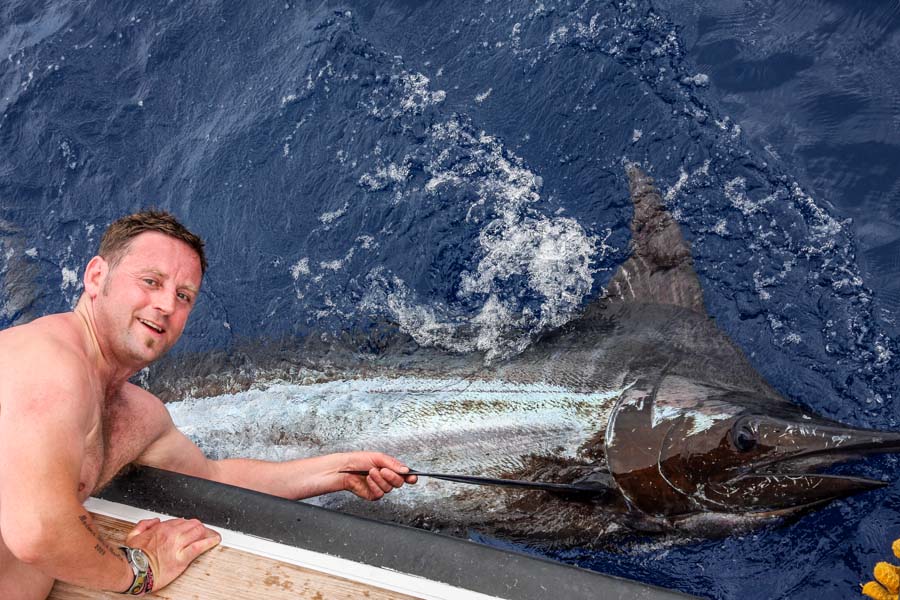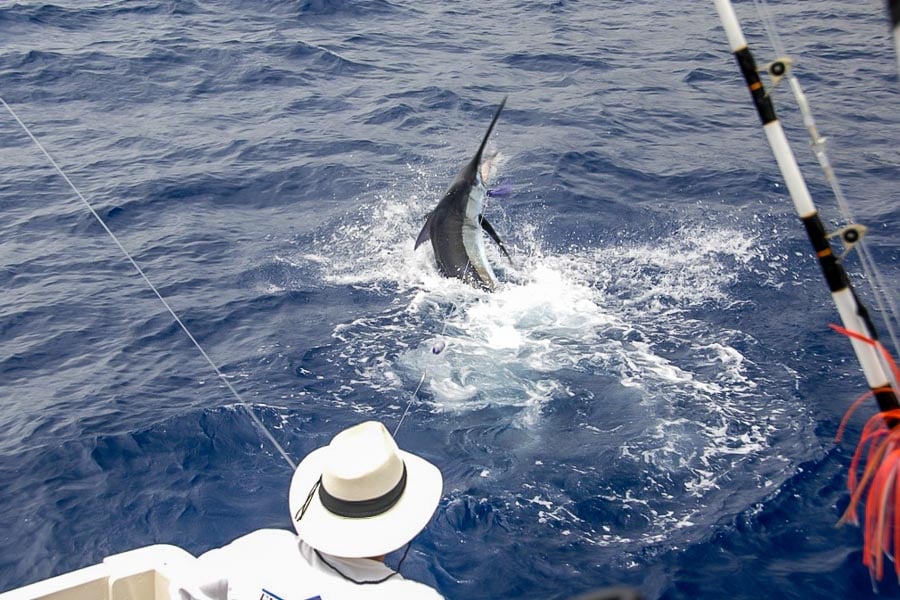Name: Blue Marlin
Scientific Name: Makaira nigricans
BLUE MARLIN Description
Native to the tropical and warm waters of the Pacific, Atlantic and Indian Oceans, Blue Marlin are among the most recognisable of all fish species. They are a striking cobalt blue on top and a silver-white belly with a pronounced dorsal fin and a long, sharp spear shaped upper jaw where it gets its name from, the bill. Known for putting up a tremendous fight when hooked, these rare marine monsters are the holy grail for sport fishers around the globe and some anglers put some serious time and money in chasing them around the oceans.
Blue Marlins prefer the higher temperature of surface waters, feeding on mackerel and tuna, but will also dive deep to eat squid. They are among the fastest fish in the ocean and use their spears to slash through dense schools, returning to eat their stunned and wounded victims.
Average BLUE MARLIN Size
The female Blue Marlin are significantly bigger than the males and can reach 14ft in length and have been landed over 1800lb. The average size to expect is between 200 – 400 lbs.
Where to catch BLUE MARLIN
They are so-called blue-water fish, spending most of their lives far out at sea. They are also highly migratory and will follow warm ocean currents for hundreds and even thousands of miles. The Blue Marlin is usually found in the warmer waters of the tropical and temperate Atlantic and the Indo-Pacific oceans. Though the Marlin has been found in temperatures ranging from 21 to 30 degree Celsius, they are found in abundance in the warm waters of about 24-degree Celsius.
They prefer to hang around weed-lines and areas where sub-surface structures and seamounts create upwellings and current and are seldom found in shallow coastal waters. Some of our popular destinations for Blue Marlin are Rodrigues Island Mauritius, Astove Atoll Seychelles, Watamu Kenya and Palmas de Cortez Mexico.
BLUE MARLIN Fishing Methods
The most used fishing method to target Blue Marlin is by trolling artificial lures, normally 5 to 7 baits in the ‘pattern’. The lure/bait that is the furthest behind the boat normal comes from the rod in the centre of the wheelhouse, above the fighting chair. This is normally around 150ft back from the boat. The next two rods set will be the two furthest left and right, these are normally positioned on the very tip of the outriggers and trolled not quite as far back as the centre high rod.
The next two rods to be set will normally be positioned in the middle of the left and right-hand gunnels and will be rigged half way along with the outriggers, these will be the closest lures/baits to the boat. There will also be a couple of lighter baited rods positioned in the boat but not live so if the chance comes, you can switch and tease the Marlin. This all sounds very complicated but all work together so that the boat can turn without tangling all the lures.
CONTACT US
Have you ever been fishing for Blue Marlin? Is this species on your list of fish to catch? If it is, and you’re ready to experience a big game fishing trip like no other, you can contact our fishing expert, Paul Stevens, via email at paul@sportquestholidays.com or call 01603 407596 today and we’ll make your dream a reality.
Alternatively, visit our big game fishing trips page containing all our fishing holidays trips and vacations.
Tight lines,
Peter











